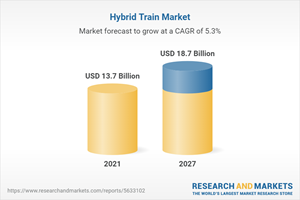Insights on the Hybrid Train Global Market to 2027 - Emerging Trend of Green Transportation Solutions is Driving Growth

Hybrid Train Market

Dublin, Aug. 26, 2022 (GLOBE NEWSWIRE) -- The "Hybrid Train Market: Global Industry Trends, Share, Size, Growth, Opportunity and Forecast 2022-2027" report has been added to ResearchAndMarkets.com's offering.
The global hybrid train market reached a value of US$ 13.71 Billion in 2021. Looking forward, the publisher expects the market to reach a value of US$ 18.73 Billion by 2027, exhibiting a CAGR of 5.34% during 2021-2027. Keeping in mind the uncertainties of COVID-19, we are continuously tracking and evaluating the direct as well as the indirect influence of the pandemic. These insights are included in the report as a major market contributor.
Hybrid train is a locomotive transportation medium that is powered by an on-board rechargeable energy storage system (RESS), in combination with other fuel, such as diesel. They are located between power source and traction transmission system that are directly connected with wheels to promote smooth operations.
They further use various energy storing devices, including supercapacitors, flywheels, and batteries, to sustain additional energy produced from regenerative braking. As compared to conventional fuel trains, hybrid trains are more reliable, emission-free, noise-free, cost-effective, and eco-friendly. At present, hybrid trains are commercially available in solar-powered, compressed natural gas (CNG), battery-operated, and electro-diesel propulsion types.
The widespread adoption of the hybrid train as a cost-effective, sustainable, and reliable mode of transportation can be attributed to the increasing scarcity of natural resources and the hiking fuel prices. This represents the key factor primarily driving the market growth.
Furthermore, the emerging trend of green transportation solutions, along with the introduction of stringency policies by governments of various nations to promote the uptake of alternative fuel-powered trains, such as hybrid trains that meet the required emission and efficiency standards, are propelling the market growth. Conventional fuel-powered trains generate various hazardous gases, including nitrogen dioxide (NO) and carbon dioxide (CO2), which is responsible for causing various ecological and health issues.
In line with this, freight companies are increasingly participating in frequent mergers and acquisitions (M&A) to collectively invest in hybrid trains, thus helping them in cutting down operating costs, including fuel and maintenance. Moreover, the incorporation of lithium-ion batteries in hybrid trains to ensure minimal power consumption, improved voltage capacity, longer charge retention is contributing to the market growth.
Other factors, such as rapid urbanization, expansion in construction activities to strengthen transportation infrastructure, and increasing railway connectivity, are positively stimulating the market growth.
Competitive Landscape:
The competitive landscape of the industry has also been examined along with the profiles of the key players being Alstom SA, Ballard Power Systems Inc., Construcciones y Auxiliar de Ferrocarriles, CRRC Corporation Limited, Hitachi Ltd., Rolls-Royce Holdings plc, Siemens AG, Stadler Rail AG, The Kinki Sharyo Co. Ltd., Toshiba Infrastructure Systems & Solutions Corporation and Vivarail Ltd.
Key Questions Answered in This Report:
How has the global hybrid train market performed so far and how will it perform in the coming years?
What has been the impact of COVID-19 on the global hybrid train market?
What are the key regional markets?
What is the breakup of the market based on the propulsion type?
What is the breakup of the market based on the operating speed?
What is the breakup of the market based on the application?
What are the various stages in the value chain of the industry?
What are the key driving factors and challenges in the industry?
What is the structure of the global hybrid train market and who are the key players?
What is the degree of competition in the industry?
Key Topics Covered:
1 Preface
2 Scope and Methodology
3 Executive Summary
4 Introduction
4.1 Overview
4.2 Key Industry Trends
5 Global Hybrid Train Market
5.1 Market Overview
5.2 Market Performance
5.3 Impact of COVID-19
5.4 Market Forecast
6 Market Breakup by Propulsion Type
6.1 Electro-Diesel
6.1.1 Market Trends
6.1.2 Market Forecast
6.2 Battery Operated
6.2.1 Market Trends
6.2.2 Market Forecast
6.3 Hydrogen Powered
6.3.1 Market Trends
6.3.2 Market Forecast
6.4 Gas Powered
6.4.1 Market Trends
6.4.2 Market Forecast
6.5 Solar Powered
6.5.1 Market Trends
6.5.2 Market Forecast
7 Market Breakup by Operating Speed
7.1 Below 100 Km/h
7.1.1 Market Trends
7.1.2 Market Forecast
7.2 100-200 Km/h
7.2.1 Market Trends
7.2.2 Market Forecast
7.3 Above 200 Km/h
7.3.1 Market Trends
7.3.2 Market Forecast
8 Market Breakup by Application
8.1 Passenger
8.1.1 Market Trends
8.1.2 Market Forecast
8.2 Freight
8.2.1 Market Trends
8.2.2 Market Forecast
9 Market Breakup by Region
10 SWOT Analysis
11 Value Chain Analysis
12 Porters Five Forces Analysis
13 Price Analysis
14 Competitive Landscape
14.1 Market Structure
14.2 Key Players
14.3 Profiles of Key Players
14.3.1 Alstom SA
14.3.1.1 Company Overview
14.3.1.2 Product Portfolio
14.3.1.3 Financials
14.3.1.4 SWOT Analysis
14.3.2 Ballard Power Systems Inc.
14.3.2.1 Company Overview
14.3.2.2 Product Portfolio
14.3.2.3 Financials
14.3.2.4 SWOT Analysis
14.3.3 Construcciones y Auxiliar de Ferrocarriles
14.3.3.1 Company Overview
14.3.3.2 Product Portfolio
14.3.3.3 Financials
14.3.4 CRRC Corporation Limited
14.3.4.1 Company Overview
14.3.4.2 Product Portfolio
14.3.5 Hitachi Ltd.
14.3.5.1 Company Overview
14.3.5.2 Product Portfolio
14.3.5.3 Financials
14.3.5.4 SWOT Analysis
14.3.6 Rolls-Royce Holdings plc
14.3.6.1 Company Overview
14.3.6.2 Product Portfolio
14.3.6.3 Financials
14.3.6.4 SWOT Analysis
14.3.7 Siemens AG
14.3.7.1 Company Overview
14.3.7.2 Product Portfolio
14.3.7.3 Financials
14.3.7.4 SWOT Analysis
14.3.8 Stadler Rail AG
14.3.8.1 Company Overview
14.3.8.2 Product Portfolio
14.3.8.3 Financials
14.3.9 The Kinki Sharyo Co. Ltd.?
14.3.9.1 Company Overview
14.3.9.2 Product Portfolio
14.3.9.3 Financials
14.3.10 Toshiba Infrastructure Systems & Solutions Corporation
14.3.10.1 Company Overview
14.3.10.2 Product Portfolio
14.3.11 Vivarail Ltd
14.3.11.1 Company Overview
14.3.11.2 Product Portfolio
For more information about this report visit https://www.researchandmarkets.com/r/ywaup5
Attachment
CONTACT: CONTACT: ResearchAndMarkets.com Laura Wood, Senior Press Manager press@researchandmarkets.com For E.S.T Office Hours Call 1-917-300-0470 For U.S./CAN Toll Free Call 1-800-526-8630 For GMT Office Hours Call +353-1-416-8900


 Yahoo Finance
Yahoo Finance 
